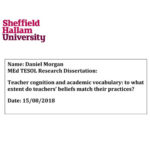Learning to Read Across Languages: Cross-Linguistic Relationships in First- and Second-Language Literacy Development
Edited by Keiko Koda and Annette M. Zehler. Routledge: New York, NY, UK: Oxon. First published 2008, transferred to Digital Printing 2010. Pp. xi + 241.
Reviewed by Anna Husson Isozaki, Gunma Prefectural Women’s University, Gunma, Japan
This ambitious volume, now digitally available, examines what is involved in the process of gaining literacy in first languages across the Asian region and how the process of gaining literacy in a second language, usually English, may then be affected.
The book is divided into two parts. Part I, “Theoretical underpinnings,” has three chapters. The first: “Learning to read: general principles and writing system variations” by Perfetti and Dunlap, is fascinating for anyone interested in comparative linguistics and includes useful charts.
In the second chapter, “Conceptual and methodological issues in comparing metalinguistic awareness across languages,” Li-jen Kuo and Richard C. Anderson sort out the terms assigned to aspects of language acquisition. They also survey research on bilinguals to illuminate what would be significant for second language learning.
In the third chapter, “Impacts of prior literacy experience on second language learning to read,” Keiko Koda provides an overview of research and current hypotheses and thoroughly discusses facets of literacy and bi-literacy needing more study. Among her suggestions for future research: how first literacy “facilitation” could vary depending on the distance between the first and second languages, an especially relevant question to teachers of English for learners from widely differing, non-European first language backgrounds.
Part II, “Languages, writing systems and learning to read,” begins with a glossary for those interested in the subject but not fully accustomed to the terminology. (Depending on the reader, however, the explanations in part one: Kuo and Anderson, might be more helpful). Next are chapters devoted to the first and second language learning-to-read process in Arabic, Chinese, Hebrew, Khmer, and Korean. The focus in each chapter is on the specific languages, as titled, but the analyses draw on a much wider range of literacy acquisition research and insights related to many more languages.
In chapter five, “Arabic literacy development and cross-linguistic effects in subsequent L2 literacy development,” Michael Fender notes the substantial difference between daily spoken Arabic and written Modern Standard Arabic (MSA) and the disparity’s possible effects on literacy. Research, however, by Abu Rabia and Feitelson cited in the chapter shows that reading aloud to young children in MSA improves their subsequent learning (p.116). This is an intriguing point as other research cited here and elsewhere in the book discusses the key significance of phonological awareness in learning to read first and second languages, though whether it develops once or separately for each language is a matter for more study (see Koda p.224-225).
Chapter six, “Learning to read Chinese” by Min Wang and Chin-lung Yang begins with an overview of Mandarin (Putonghua), which is used across the PRC in schools. Mandarin is a first language but as distance increases from Beijing, it becomes a second language, distinct from that of home and daily life (p.147). The importance of graphic versus phonological processing in reading Chinese is discussed at length, and Perfetti and other researchers have suggested that the timing of phonological processing may be a pivotal question (p.139).
In chapter seven Esther Geva reviews literacy studies and investigates their applicability to learning to read Hebrew as a first or second language. Geva discusses findings of children from Ethiopian immigrant Amharic-speaking homes having difficulties in Hebrew literacy acquisition compared to Israeli children from the same economic level. Unequal language skills persist, beginning with lower phonological and phonemic awareness in kindergarten and later becoming more of a morphological awareness issue for these Hebrew L2 children, and she calls for more research into the causes (p169-171). Dyslexia studies are also examined in this chapter, and indications that English is more problematic for matched dyslexics than is Hebrew (p.176-177).
In chapter eight, “Learning to read in Khmer,” Annette M. Zehler and Saloni Sapru introduce the Cambodian alphabetic-syllabic written language and despite the lack of research relating to development of Khmer literacy, nevertheless provide a systematic overview. They also report a dearth of studies of English literacy development in Khmer speakers, reflecting the ongoing trauma to the education system that remains a legacy of the Khmer Rouge. Last, the authors mention some current efforts being made for Khmer language and culture education in Cambodia and elsewhere.
The final case language, Korean, examined in chapter nine by Eunyoung Christine Park, details the process of learning to read Korean and observes that parental involvement in early childhood literacy-building is so prevalent that literacy became nearly universal by the mid-1990s (p.213). Park gives an overview of research investigating L2 English literacy acquisition by Korean learners as compared with other L1 learners, and what is known to date about potentially transferable skills, calling for more research on the aspects not yet fully understood.
Keiko Koda consolidates the entries in “Looking back and thinking forward,” surveying what is well-researched and the questions still unanswered. She warns against correlational evidence being prematurely labeled “transfer” (p.225) or, for example, interpreting decoding skills in terms potentially conflating “decoding” with comprehension (p.228). She points out that comprehension, after all, is the goal for literacy students, and makes many recommendations for research yet to be done.
Overall, the volume is useful for linguistic perspective and helpful for those interested in possible directions for research of their own. The terminology in the chapters can sometimes be dense and challenging for non-specialists in the field, but the glossary sections make it more navigable.
Learning the Read Across Languages is highly recommended for anyone serious about developing a linguistic understanding of the complex questions to be answered about learning to read in first and second languages, and as a foundation in cutting edge cross-lingual literacy research, particularly across the Asian region, and when the second literacy being developed is English.
Anna Husson Isozaki has been teaching English for twenty years in Japan. Her research interests include: content-based and collaborative learning, L2 literacy acquisition, and literature and critical thinking in the L2 classroom.








